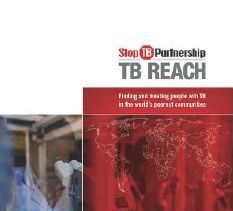
The use of new technologies and approaches to actively seek out people with tuberculosis can significantly increase the number of people diagnosed and put on treatment.
15 November - Kuala Lumpur - Results presented today from the first year of the Stop TB Partnership's TB REACH initiative show that the use of new technologies and approaches to actively seek out people with tuberculosis (TB) can significantly increase the number of people diagnosed and put on treatment. This encouraging outcome offers hope to the 3 million people currently going without TB care each year.
Using a range of innovations, including mobile phone technology and the Xpert MTB/RIF diagnostic test, Stop TB Partners implementing the first 30 TB REACH projects found an average of 25% more people with TB in their project areas compared to the year before. In more than half of the projects the increase was 50% and in some projects as much as 100%.
Based on historical trends, the project areas would normally have seen a 1.2% annual rise in the number of people found with TB-the equivalent of 820 people. The TB REACH projects found 18 043 people with TB who would otherwise have gone without treatment-representing a more than twenty-fold increase.
Of the estimated 9 million people who get ill with TB a year, 3 million people-often in the poorest most vulnerable groups-go without a proper diagnosis or treatment for TB.
"The number of 'lost' people has remained stubbornly around the three million mark for the past six years, despite the availability of low-cost TB care and the arrival of new diagnostic technologies. This is a global failure that we can no longer ignore if we want to end TB deaths and halt the spread of drug-resistant TB," said Dr Lucica Ditiu, Executive Secretary of the Stop TB Partnership.
"Our partners' impressive results are evidence that if we are focused and ambitious we can reach all of those in need," Dr Ditiu said. "I hope that these results are the inspiration that countries need to make bold plans for scaling up their responses to TB, and indeed some of the project ideas have already attracted sustainable long-term funding. Similarly, our work at TB REACH is not done. We must continue to incubate innovation and impact through the future waves of TB REACH funding."
TB REACH was launched in January 2010 with a US$ 120 million grant from the Canadian International Development Agency. The initiative provides fast-track grants of up to US$ 1 million to projects that find and treat people with TB using innovative approaches in populations that are poor and vulnerable and have limited access to care. An independent Proposal Review Committee selects the projects and an independent monitoring and evaluation agency is responsible for measuring progress and validating results.
Wave one grant recipients include the Indus Hospital in Pakistan, which is using mobile phones and financial incentives to help a network of private clinics serving poor communities in Karachi find twice as many people with tuberculosis (TB) in 2011 compared to the previous year. In Lesotho, the Foundation for Innovative New Diagnostics employed a unique combination of horseback riders and mobile phone text messaging to reach people in remote mountainous villages. In Mbeya, Tanzania, a partnership between the University of Munich and the National Institute for Medical Research has for the first time introduced GeneXpert MTB/RIF technology at rural health centres and on a mobile van.
Click here to read the full wave one results report.
Source: Stop TB Partnership